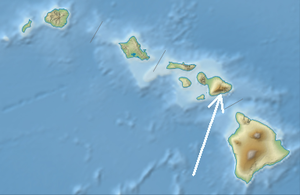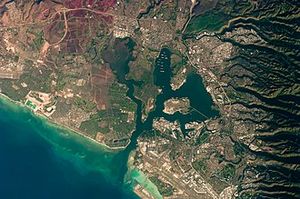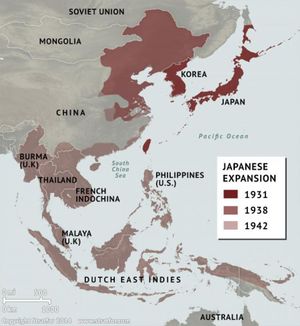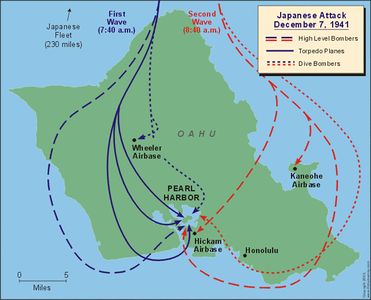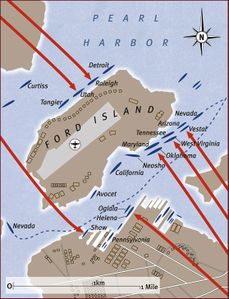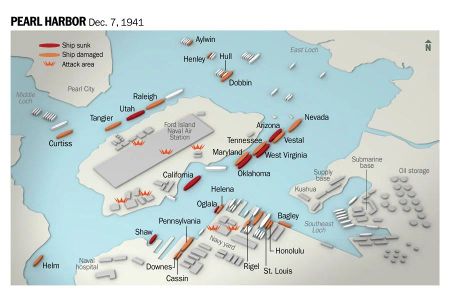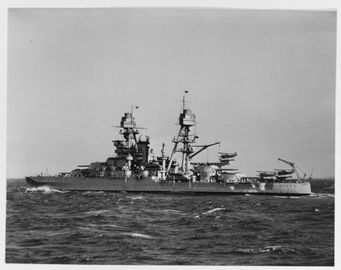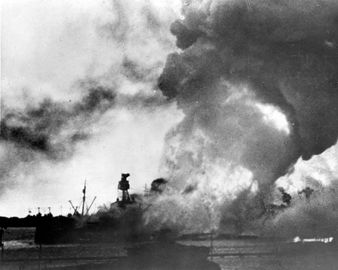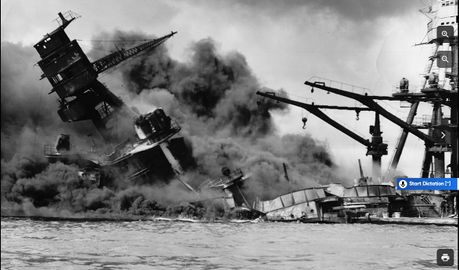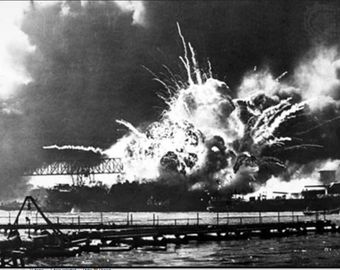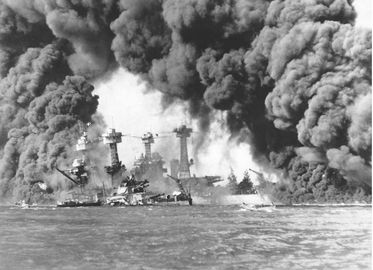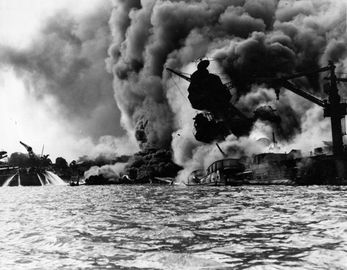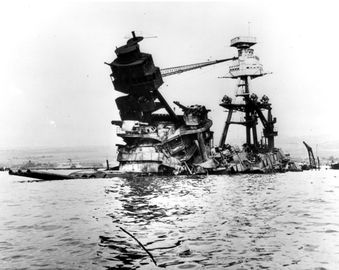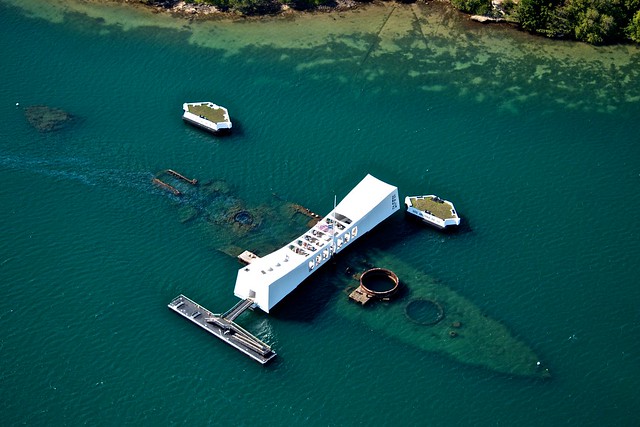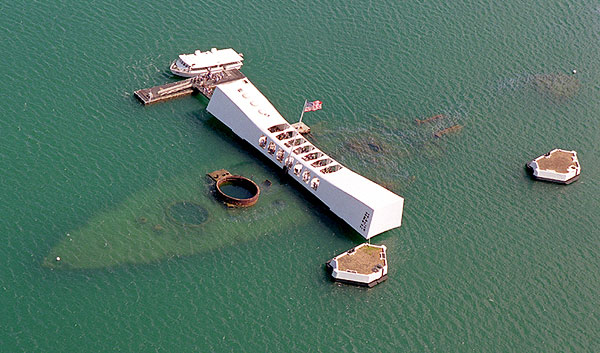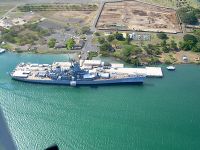Pearl Harbor
Pearl Harbor is an American lagoon harbor on the island of Oahu, Hawaii, west of Honolulu. It was often visited by the Naval fleet of the United States before it was acquired from the Hawaiian Kingdom by the U.S. with the signing of the Reciprocity Treaty of 1875. Much of the harbor and surrounding lands are now a United States Navy deep-water naval base. It is also the headquarters of the United States Pacific Fleet. The U.S. government first obtained exclusive use of the inlet and the right to maintain a repair and coaling station for ships here in 1887. The surprise attack by the Imperial Japanese Navy on December 7, 1941, led the United States to declare war on the Empire of Japan, attacking Pearl Harbor the immediate cause of the United States' entry into World War II.
- More information is available at [ Wikipedia:Pearl_Harbor ]
History
Pearl Harbor was originally an extensive shallow embayment called Wai Momi (meaning, "Waters of Pearl") or Puʻuloa (meaning, "long hill") by the Hawaiians. Puʻuloa was regarded as the home of the shark goddess, Kaʻahupahau, and her brother (or son), Kahiʻuka, in Hawaiian legends. According to tradition, Keaunui, the head of the powerful Ewa chiefs, is credited with cutting a navigable channel near the present Puʻuloa saltworks, by which he made the estuary, known as "Pearl River", accessible to navigation. Making due allowance for legendary amplification, the estuary already had an outlet for its waters where the present gap is; but Keaunui is typically given the credit for widening and deepening it.
Following the overthrow of the Hawaiian Kingdom, the United States Navy established a base on the island in 1899. On December 7, 1941, the base was attacked by the Imperial Japanese Navy airplanes and midget submarines, causing the American entry into World War II. There was no meaningful plan for the air defense of Hawaii, for American commanders had no understanding of the capabilities and proper employment of air power. As it was, had the Pacific Fleet acted on the war warnings it undoubtedly would have sortied and been at sea on December 7, where the major ships would have been sunk in deep water, making salvage impossible. Shortly after the devastating Japanese surprise attack at Pearl Harbor, two American military commanders, Lt. Gen. Walter Short and Adm. Husband Kimmel, were demoted of their full ranks. The two American commanders later sought to restore their reputations and full ranks.[Note 1]
Motives for Pearl Harbor attack
Japan, like Great Britain, is an island nation and is therefore dependent upon extra- national importation of raw materials. Beginning in 1931, Japan, through armed conflict, seized many of its trade partners and neighbors. When trade breaks down, armed conflict usually follows. Many of those Nations captured had treaties with the United States and the US began an embargo of goods, including, iron, oil, and rubber, going to Japan. Seeing an inevitable state of war between Japan and the United States, Japan decided to strike first and cripple the US Navy fleet at Pearl Harbor. .
Sunday 7 December 1941
Aircraft and midget submarines of the Imperial Japanese Navy under the command of Admiral Chuichi Nagumo began bombing Honolulu at the U.S. naval base. Through earlier code breaking activity, the Americans had determined that an attack was likely to occur. However, as the Americans failed to discover Japan's target location, it was believed that the Philippines was the most likely target. At 06:05 on 7 December, the six Japanese carriers launched a first wave of 183 aircraft composed mainly of dive bombers, horizontal bombers and fighters.
The Japanese struck American ships and military installations at 07:51. The first wave attacked airfields of Ford Island. At 08:30, a second wave of 170 Japanese aircraft, mostly torpedo bombers, attacked the fleet anchored in Pearl Harbor. The battleship Arizona was hit with an armor-piercing bomb which penetrated the forward ammunition compartment, sinking it within seconds, killing 1,177 crew members.
The overall death toll was 2,467 people: 2,403 American citizens—2,335 members of the U.S. military and 68 civilians—and 64 members of the Imperial Japanese Navy. Five U.S. battleships were sunk and the other remaining three were badly damaged. Overall, nine ships of the U.S. fleet were sunk and 21 ships were severely damaged. Three of the 21 would be irreparable. 188 U.S. aircraft were completely destroyed and 159 others were damaged. Japan lost 29 out of the 353 aircraft they attacked with. The attack on Pearl Harbor was the largest attack committed by foreign nationals on American soil in peacetime and in general prior to the September 11 attacks.
The first shots fired were from the destroyer Ward on a midget submarine that surfaced outside of Pearl Harbor; Ward sank the midget sub at approximately 06:55, about an hour before the attack on Pearl Harbor.
- Japanese attack on Pearl Harbor
- Gallery showing damage on USS Arizona
- USS Arizona Monument
USS Missouri
USS Missouri (BB-63) ("Mighty Mo" or "Big Mo") is a United States Navy Iowa-class battleship, and was the fourth ship of the U.S. Navy to be named in honor of the U.S. state of Missouri. Missouri was the last battleship built by the United States, and was the site of the surrender of the Empire of Japan which ended World War II.
Missouri was ordered in 1940 and commissioned in June 1944. In the Pacific Theater of World War II she fought in the battles of Iwo Jima and Okinawa and shelled the Japanese home islands, and she fought in the Korean War from 1950 to 1953. She was decommissioned in 1955 into the United States Navy reserve fleets (the "Mothball Fleet"), but reactivated and modernized in 1984 as part of the 600-ship Navy plan, and provided fire support during Operation Desert Storm in January/February 1991.
Missouri received a total of 11 battle stars for service in World War II, Korea, and the Persian Gulf, and was finally decommissioned on 31 March 1992, but remained on the Naval Vessel Register until her name was struck in January 1995. In 1998, she was donated to the USS Missouri Memorial Association and became a museum ship at Pearl Harbor, Hawaii.
Notes
- ↑ On May 25, 1999, the United States Senate, by a vote of 52–47, passed a non-binding resolution to exonerate Kimmel and Short and requested that the President of the United States posthumously restore both men to full rank. Senator Strom Thurmond, one of the sponsors of the resolution, called Kimmel and Short "the two final victims of Pearl Harbor." The Senate inquiry in 2000 issued a lengthy exoneration of Kimmel's conduct. President Clinton did not act on the resolution, nor have any of his successors.
A Personal Note from Robin
When I received orders to join USS Duncan in Japan, I made a stop at Pearl Harbor and visited the Arizona Monument.
USS Missouri had not yet become a museum ship at that time.
External links
Chat rooms • What links here • Copyright info • Contact information • Category:Root
